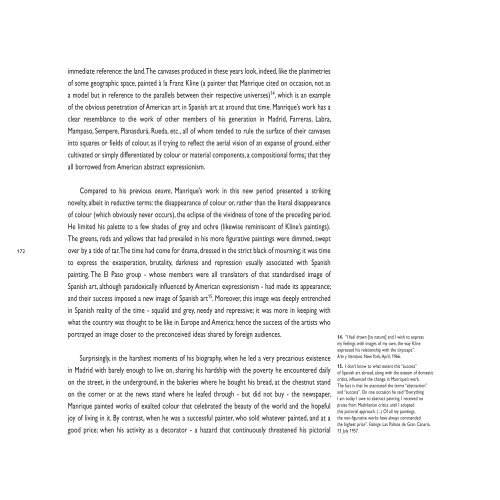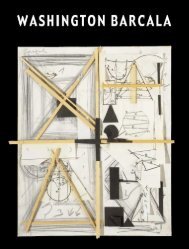VERSIÓN INGLESA ENGLISH VERSION - Fundación César Manrique
VERSIÓN INGLESA ENGLISH VERSION - Fundación César Manrique
VERSIÓN INGLESA ENGLISH VERSION - Fundación César Manrique
You also want an ePaper? Increase the reach of your titles
YUMPU automatically turns print PDFs into web optimized ePapers that Google loves.
172<br />
immediate reference: the land. The canvases produced in these years look, indeed, like the planimetries<br />
of some geographic space, painted à la Franz Kline (a painter that <strong>Manrique</strong> cited on occasion, not as<br />
a model but in reference to the parallels between their respective universes) 14 , which is an example<br />
of the obvious penetration of American art in Spanish art at around that time. <strong>Manrique</strong>’s work has a<br />
clear resemblance to the work of other members of his generation in Madrid, Farreras, Labra,<br />
Mampaso, Sempere, Planasdurá, Rueda, etc., all of whom tended to rule the surface of their canvases<br />
into squares or fields of colour, as if trying to reflect the aerial vision of an expanse of ground, either<br />
cultivated or simply differentiated by colour or material components, a compositional forms¡ that they<br />
all borrowed from American abstract expressionism.<br />
Compared to his previous oeuvre, <strong>Manrique</strong>’s work in this new period presented a striking<br />
novelty, albeit in reductive terms: the disappearance of colour or, rather than the literal disappearance<br />
of colour (which obviously never occurs), the eclipse of the vividness of tone of the preceding period.<br />
He limited his palette to a few shades of grey and ochre (likewise reminiscent of Kline’s paintings).<br />
The greens, reds and yellows that had prevailed in his more figurative paintings were dimmed, swept<br />
over by a tide of tar. The time had come for drama, dressed in the strict black of mourning; it was time<br />
to express the exasperation, brutality, darkness and repression usually associated with Spanish<br />
painting. The El Paso group - whose members were all translators of that standardised image of<br />
Spanish art, although paradoxically influenced by American expressionism - had made its appearance;<br />
and their success imposed a new image of Spanish art 15 . Moreover, this image was deeply entrenched<br />
in Spanish reality of the time - squalid and grey, needy and repressive; it was more in keeping with<br />
what the country was thought to be like in Europe and America; hence the success of the artists who<br />
portrayed an image closer to the preconceived ideas shared by foreign audiences.<br />
Surprisingly, in the harshest moments of his biography, when he led a very precarious existence<br />
in Madrid with barely enough to live on, sharing his hardship with the poverty he encountered daily<br />
on the street, in the underground, in the bakeries where he bought his bread, at the chestnut stand<br />
on the corner or at the news stand where he leafed through - but did not buy - the newspaper,<br />
<strong>Manrique</strong> painted works of exalted colour that celebrated the beauty of the world and the hopeful<br />
joy of living in it. By contrast, when he was a successful painter, who sold whatever painted, and at a<br />
good price; when his activity as a decorator - a hazard that continuously threatened his pictorial<br />
14. “I feel drawn [to nature] and I wish to express<br />
my feelings with images of my own, the way Kline<br />
expressed his relationship with the cityscape”.<br />
Arte y literatura. New York, April, 1966.<br />
15. I don’t know to what extent this “success”<br />
of Spanish art abroad, along with the esteem of domestic<br />
critics, influenced the change in <strong>Manrique</strong>’s work.<br />
The fact is that he associated the terms “abstraction”<br />
and “success”. On one occasion he said “Everything<br />
I am today I owe to abstract painting. I received no<br />
praise from Madrilenian critics until I adopted<br />
this pictorial approach. (...) Of all my paintings,<br />
the non-figurative works have always commanded<br />
the highest price”. Falange. Las Palmas de Gran Canaria,<br />
13 July 1957.
















![Becas y premios de la Fundación César Manrique [1997-2006]](https://img.yumpu.com/20766851/1/184x260/becas-y-premios-de-la-fundacion-cesar-manrique-1997-2006.jpg?quality=85)
